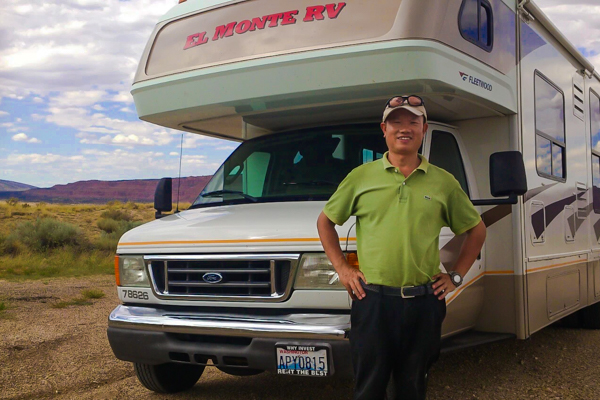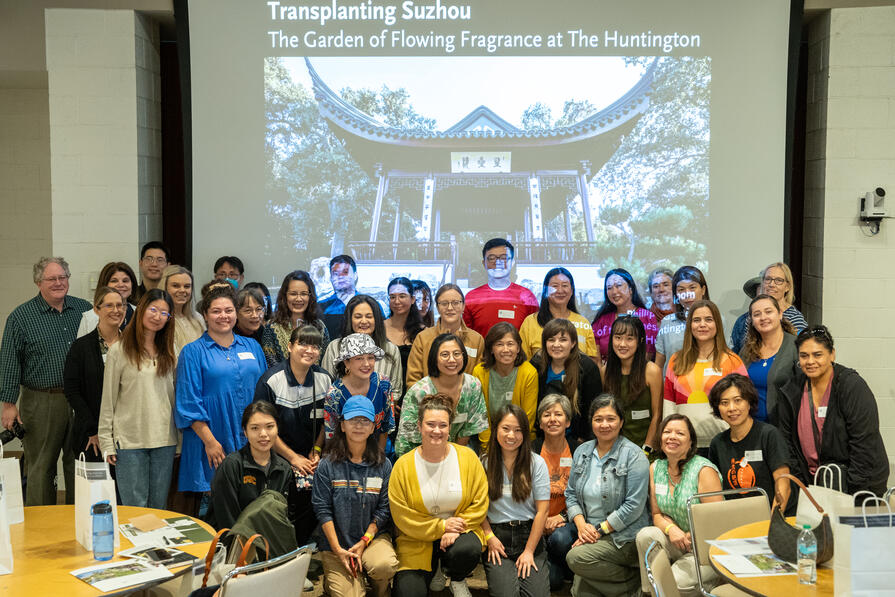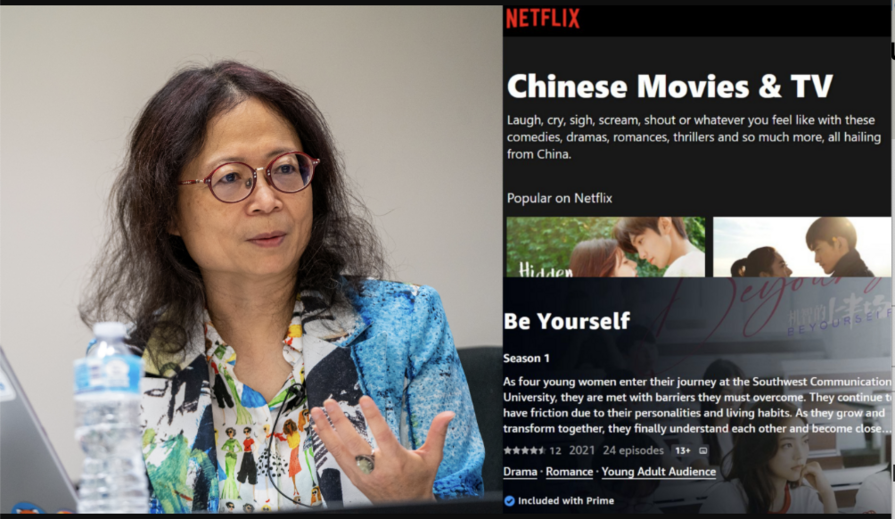Originally published by US-China Today on December 6, 2016. Written by Nicole Zhang and Anna Lipscomb.
On an idyllic Wyoming morning, Ms. Shang (who chose only to be identified by her last name) and her family emerge from their recreational vehicle (RV) at Grand Teton National Park and gaze upon the scenery of mountains in the distance. Squirrels jump from tree to tree and several spotted horses graze nearby. A few feet from their doorstep is another RV housing an older American couple. They exchange smiles and friendly greetings every day.
At night, the neighboring caravans sit around a bonfire, chatting with their family and new friends. "RV road trips minimizes the distance between people, and it pulls us closer to nature," Shang wrote in her blog, 15-Day West Coast RV Road Trip, in which she details the trip she and her family took in America in 2014.
 Shang is one of the estimated 2.19 million Chinese tourists who came to the United States in 2014, with 2.56 million in 2015. Out of their desire for a more customized trip, Shang, and an increasing number of other Chinese, have opted to experience America in a new, distinctly foreign way — in a RV.
Shang is one of the estimated 2.19 million Chinese tourists who came to the United States in 2014, with 2.56 million in 2015. Out of their desire for a more customized trip, Shang, and an increasing number of other Chinese, have opted to experience America in a new, distinctly foreign way — in a RV.
This growing trend of Chinese travelers taking RV road trips in the U.S. signals a shift in the Chinese traveling culture towards freedom, flexibility and exploration. This fits with the growth of the Chinese economy and rise of an educated, urban middle-upper class that can afford these new experiences and is eager to have them.
In a survey conducted by Mafengwo, a popular online Chinese travel discussion site, and Zuzuche, an online car rental platform, 29% of respondents reported an annual income of $38,685-$74,394. Furthermore, nearly 61% of the self-driving tourists come from first-tier Chinese cities. Many of them are groups of young families, friends and outdoor enthusiasts who enjoy sightseeing, shopping, vacationing and other leisure activities.
Joe Laing, the director of marketing for El Monte RV, a popular rental company for Chinese tourists, says, “The US is seen as the RV capital of the world. If you like RVs and you’re in another country, there’s a high probability you’re going to want to come here to try it out.”
Growing Interest
The growing interest in RV travel by Chinese tourists is partly due to the increasing popularity of cars in China. Over the last two decades, car ownership has become commonplace — no longer just for the super wealthy. More than 280 million automobiles and 327 million drivers hit the road in China in 2015, according to the Ministry of Public Security. Now, China is the largest market for automobiles in the world; many of these now touring by car in China and are ready to drive themselves abroad as well.
According to Craig Kirby, Senior Vice President Government Relations and General Counsel at the Recreation Vehicle Industry Association (RVIA), “Car ownership has helped fuel the growth of the so-called 'self-driving' tourists — motor tourists who take road trips to visit friends and family, spend holidays or vacations out of town. Self-driving has become mainstream.”
 Chinese tourists’ increasing confidence in driving on urban roads encourages them to self-drive RVs in America, which provides more freedom and adventure of travelling compared to the traditional, structured group tours.
Chinese tourists’ increasing confidence in driving on urban roads encourages them to self-drive RVs in America, which provides more freedom and adventure of travelling compared to the traditional, structured group tours.
Mr. Liu (who chose only to be identified as his last name), a 40-year old Chinese tourist from Guangzhou who visited America in 2011, says, “During our RV trip, we drove through several national parks including Grand Teton National Park, Yellowstone National Park and Mount Rainier National Park. Within these 20 days, we were able to pass by 10 different states and see natural sites that we would not be able to see otherwise.” In addition to national parks, many Chinese tourists enjoy going to entertainment venues such as Las Vegas and shopping centers in their RVs, especially since tourists can fill them up with their purchases.
The growing interest in RVs among Chinese tourists, according to Joe Laing, is reflective of a travel cycle in China. He says that the travel markets of countries, including China, progress through cycles where tourists start touring cities, then join package/group tours, and then finally drive their own RVs. “Usually by the time they get to us, they’ve already been through most of the cycle and they’re just looking for other ways of travelling.”
Chinese social media and entertainment have also played a role in the rising popularity of RVs among Chinese tourists. According to Laing, “When people come over here, they’re sharing on WeChat and their friends see it, and then they think: Wow, this is something I want to do.” Laing thinks Be There or Be Square (不见不散 bujian busan), a popular “New Year” film from 1998 by director Feng Xiaogang is part of the inspiration for the RV rush.
The Business of International RV Rentals
RV road trips require a great deal of time and preparation for both the Chinese tourists and the RV companies renting to them.
When Liu and his family went on their road trip to America, they had to carefully plan out their finances, bring along items such as sunscreen and emergency medicine and obtain an international driver’s license. They were also tasked with planning out the routes and the schedule, as well as considering which RV option best fit their group.
According to Laing, the pricing of an RV varies by season, with summer being the peak season (rates of $200-300 a day). Spring and fall rates usually range between $100-200, and between the months of September and March, rates can be as low as $50-100, depending on the vehicle. Therefore, a 10-day RV trip typically ranges from $1,000-3,000 (not including gas, campground fees and more). Often times, groups of families will travel together, splitting the price of the motorhome.
About 50% of El Monte RV’s overall business comes from overseas visitors, so they have a great deal of experience working and adapting to international crowds. With an increasing number of Chinese tourists travelling to America, the RV industry along with its associated companies is making changes to adjust to the needs of its customers. For example, some companies have developed language-related resources specifically for their international customers.
Laing says, “We had to develop a Chinese [instructional video] in the last few years because they were coming our way, so we wanted to make sure they knew how to operate the vehicles.” Along with English and Chinese, El Monte RV also offers videos in German, French, Dutch, Italian, Spanish, Japanese and Korean.
In addition to these videos, they have created additional resources, such as having rice cookers in the some of the RVs or providing maps that help Chinese tourists locate the nearest Chinese grocery store.
Because of these additional resources developed by the rental companies, international customers are able to take full advantage of the benefits that RVs offer, such as tailoring their travel experience to their cultural needs and preferences. Ms. Shang and her family used the RV’s kitchen and rice cookers to prepare their own meals around their own schedule, without having to drive far to find a Chinese buffet or wait in lines. Similarly, Liu says that one of his favorite aspects of traveling by RVs is making dinner with his family: "Having the taste of home while traveling in a foreign country gives us the most gratifying feeling."
Hitting a Roadblock
 For Chinese visitors self-driving RVs, they may be challenged by the differences in traffic rules. "We almost got in trouble while driving on our way to Yellowstone National Park," Liu says, "That was a first time my friend drove an RV. The road was narrow and packed. When a big truck drove past us, my friend got nervous and our blind spot mirror scraped on the truck’s blind spot mirror. My friend freaked out so much that he forgot to hit the brake and laid down across the passenger seat. The RV slightly leaned over. The RV could have flipped over if I did not immediately take control of the wheel."
For Chinese visitors self-driving RVs, they may be challenged by the differences in traffic rules. "We almost got in trouble while driving on our way to Yellowstone National Park," Liu says, "That was a first time my friend drove an RV. The road was narrow and packed. When a big truck drove past us, my friend got nervous and our blind spot mirror scraped on the truck’s blind spot mirror. My friend freaked out so much that he forgot to hit the brake and laid down across the passenger seat. The RV slightly leaned over. The RV could have flipped over if I did not immediately take control of the wheel."
Driving in an unfamiliar environment with different traffic rules can be nerve racking and even some dangerous. In August 2016, a Chinese family was involved in a highway chase in San Diego because they were unfamiliar with the route and made frequent stops on the highway, arousing the suspicion of the police. According to a local news source, the family didn’t realize they were supposed to stop and pull over for the police when the lights and sirens sounded at them.
Although an increasing number of Chinese tourists are familiar with urban driving and cars, they may also face potential problems relating to the operation of the vehicles. Both Liu and Shang had to get used to operating the steering because RVs are significantly larger and heavier than normal vehicles. There is also a steep learning curve with understanding how to hook up the water and sewage pumps, though videos and instructions help with this.
Even so, a growing class of Chinese drivers will likely make these tourists more confident in RV road trips. Laing says, “The more Chinese drivers there are, the more likely there are people to come over here and rent motor homes with less of a barrier.”
In the beginning waves of Chinese tourists taking RV road trips, language barriers were an initial challenge. According to Laing, some tourists would bring interpreters with them or request that the dealer provide a driver. However, as greater numbers of Chinese tourists come to America, the American tourism industry is growing increasingly accustomed to serving these international tourists. “Almost all tourist destinations now have so much experience with Chinese travelers,” says Laing, “They already expect international tourists.”
Rising education levels and more experience using English, have, along with greater American cultural fluency, reduced these barriers and make RV trips reasonable options for many. When Liu and his family went on their road trip, his son had no problem communicating in English since he goes to high school in the U.S. Liu explains, “That is one of the main prerequisites that makes the trip possible."
“Most of the travelers that travel in RVs are fairly sophisticated, often with at least a rudimentary grasp of English,” says Laing. “I think most of the barrier right now is just people’s fear of the unknown. They are not used to it and they haven’t done it.”
 This growing trend is still in its early stages, and Chinese tourists are still exploring this new way of traveling. It has not yet reached its peak.
This growing trend is still in its early stages, and Chinese tourists are still exploring this new way of traveling. It has not yet reached its peak.As the outbound RV tourist market grows, the market for RVs in China is also growing. In the beginning in China there was a lack of infrastructure for RVs, such as campgrounds, repair facilities, road, services and rental firms. “We had to start from scratch with the Chinese,” says Kirby.
He and RVIA are working with both central and local governments in China to bring RVs to the national and local economies. Recently the central government included access to RVs and camping as one of its priorities in the 2016-2020 5-year plan. According to Kirby, “Two thousand [RV] campgrounds are scheduled to be built by 2020, a significant increase from the current two hundred.”
He predicts that the number of China’s outbound tourists will continue to grow, benefiting the U.S. RV industry as more and more Chinese tourists learn about RV road trips as a form of travel and exploration.
Visa changes between the U.S. and China have encouraged the continuous growth in the international RV business and tourism. “Being able to get a ten year visa now makes things so much easier,” Laing says, “Once the Chinese traveler gets a visa for the United States, they have a real opportunity to pass the tourism buy cycle.” In other words, the extended length of the visa makes it convenient for Chinese visitors to return to the U.S., and encourages them to continue exploring and consuming a range of different travel experiences. “I think because of the visa and because of the expanding middle class and driver classes in China, I think we are seeing a real change,” Laing says.
Even with economists’ concerns for a slowdown in the Chinese economy, Laing says, “I think it would take a long-term recession situation before we would see a decrease, because most people are just finding out and they are just discovering what they can do with the RVs.”




